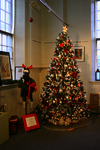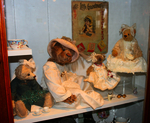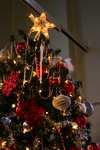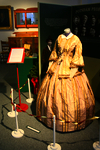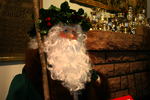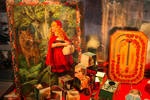
VICTORIAN STYLE
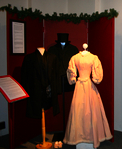 TOP HATS: During this era working class men usually wore top hats made of rabbit fur, while the upper class men wore top hats made from beaver fur. The use of beaver skin was in such high demand because of its water proof properties for top hats and coats that it nearly wiped out the beaver in America by 1900. An example here is a top hat donated from the Cook Estate.
TOP HATS: During this era working class men usually wore top hats made of rabbit fur, while the upper class men wore top hats made from beaver fur. The use of beaver skin was in such high demand because of its water proof properties for top hats and coats that it nearly wiped out the beaver in America by 1900. An example here is a top hat donated from the Cook Estate.
BUTTON-UP BOOTS & SHOES: Women’s boots and shoes were almost always worn with heels and had either pointed or squared toes. They were also decorated with lace, bows, tassels, and buttons. Some of the examples here include donations from Malcolm McCormick, Mrs. Lee Fenner, and from the Snell collection.
FEATHER FANS: Fans became quite fashionable during the Victorian Era, www.holamalls.com trimmed with either a light feather edging of marabout or made entirely of natural or dyed feathers of different varieties. An example here shows a black fan made of ostrich feathers donated by Myron and Eunice Mochel.
CANES: Men used walking sticks as a measure of social status and would often keep a variety of canes for different occasions. Examples here include; a gold headed cane with a B engraved on the head which came from the Batchelder estate and another cane once owned by Isaac Mathews.
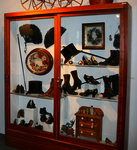 PURSES: Purses made during the Victorian era came in a large array of styles and fabrics. Women would embroider purses with the goal to show them off to their potential husbands. Women also wore chatelaines, decorative belt hooks or clasps worn at the waist with a series of chains with a bag-like holder suspended from it. An example shown here is a black beaded chatelaine purse donated by Helen Reynolds.
PURSES: Purses made during the Victorian era came in a large array of styles and fabrics. Women would embroider purses with the goal to show them off to their potential husbands. Women also wore chatelaines, decorative belt hooks or clasps worn at the waist with a series of chains with a bag-like holder suspended from it. An example shown here is a black beaded chatelaine purse donated by Helen Reynolds.
CHILDREN'S SHOES: Victorian children were expected to be very well-dressed and well-behaved whether they were rich or poor and since the time period was known for its extravagant fashions, their shoes became part of their fashion standards. Children’s shoes would imitate those worn by adults made with fine leather and decorated with buckles, buttons, or fine lace. Examples here include donations from the Sanford, Scaturro, Cassel, Powers, and Crumb Estates.
THE VICTORIAN PARLOR
 TOP HATS: During this era working class men usually wore top hats made of rabbit fur, while the upper class men wore top hats made from beaver fur. The use of beaver skin was in such high demand because of its water proof properties for top hats and coats that it nearly wiped out the beaver in America by 1900. An example here is a top hat donated from the Cook Estate.
TOP HATS: During this era working class men usually wore top hats made of rabbit fur, while the upper class men wore top hats made from beaver fur. The use of beaver skin was in such high demand because of its water proof properties for top hats and coats that it nearly wiped out the beaver in America by 1900. An example here is a top hat donated from the Cook Estate.BUTTON-UP BOOTS & SHOES: Women’s boots and shoes were almost always worn with heels and had either pointed or squared toes. They were also decorated with lace, bows, tassels, and buttons. Some of the examples here include donations from Malcolm McCormick, Mrs. Lee Fenner, and from the Snell collection.
FEATHER FANS: Fans became quite fashionable during the Victorian Era, www.holamalls.com trimmed with either a light feather edging of marabout or made entirely of natural or dyed feathers of different varieties. An example here shows a black fan made of ostrich feathers donated by Myron and Eunice Mochel.
CANES: Men used walking sticks as a measure of social status and would often keep a variety of canes for different occasions. Examples here include; a gold headed cane with a B engraved on the head which came from the Batchelder estate and another cane once owned by Isaac Mathews.
 PURSES: Purses made during the Victorian era came in a large array of styles and fabrics. Women would embroider purses with the goal to show them off to their potential husbands. Women also wore chatelaines, decorative belt hooks or clasps worn at the waist with a series of chains with a bag-like holder suspended from it. An example shown here is a black beaded chatelaine purse donated by Helen Reynolds.
PURSES: Purses made during the Victorian era came in a large array of styles and fabrics. Women would embroider purses with the goal to show them off to their potential husbands. Women also wore chatelaines, decorative belt hooks or clasps worn at the waist with a series of chains with a bag-like holder suspended from it. An example shown here is a black beaded chatelaine purse donated by Helen Reynolds.CHILDREN'S SHOES: Victorian children were expected to be very well-dressed and well-behaved whether they were rich or poor and since the time period was known for its extravagant fashions, their shoes became part of their fashion standards. Children’s shoes would imitate those worn by adults made with fine leather and decorated with buckles, buttons, or fine lace. Examples here include donations from the Sanford, Scaturro, Cassel, Powers, and Crumb Estates.
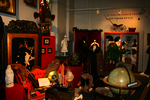 In Victorian times, the parlor was the best room of the house, reserved for special occasions, or special visitors. It contained family photographs and other treasured possessions. It might have contained an organ or piano. Vases, statuettes, lamps, and dried flowers would have revealed the family’s social position and taste. The parlor table would have proudly displayed the family Bible. The furniture, while the nicest that the family could afford, was selected for its appearance rather than comfort.
In Victorian times, the parlor was the best room of the house, reserved for special occasions, or special visitors. It contained family photographs and other treasured possessions. It might have contained an organ or piano. Vases, statuettes, lamps, and dried flowers would have revealed the family’s social position and taste. The parlor table would have proudly displayed the family Bible. The furniture, while the nicest that the family could afford, was selected for its appearance rather than comfort.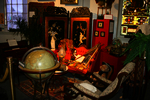 During the nineteenth century, people found that they had more leisure time than previous generations had enjoyed. This led to the creation of various forms of recreation, including games played indoors and outdoors. Since the indoor games were often played in the family parlor, they became known as parlor games. Formal musical recitals could also have been held in the parlor.
During the nineteenth century, people found that they had more leisure time than previous generations had enjoyed. This led to the creation of various forms of recreation, including games played indoors and outdoors. Since the indoor games were often played in the family parlor, they became known as parlor games. Formal musical recitals could also have been held in the parlor. 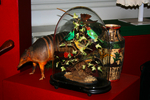 Domed glass displays, featuring birds, and unusual stuffed animals such as armadillos, were also found in many Victorian parlors. Crazy quilts were patchwork quilts with irregular pieces without a repeating pattern, hence a “crazy” design. The Japanese exhibition at the 1876 Philadelphia Centennial Exhibition inspired the crazy quilt with its asymmetrical art. By the early 1880’s, crazy quilting became a very popular fad in the United States, which would last into the early Edwardian era (1901-1910). Outside activities popular during the Victorian era included snowshoeing, croquet, and tennis.
Domed glass displays, featuring birds, and unusual stuffed animals such as armadillos, were also found in many Victorian parlors. Crazy quilts were patchwork quilts with irregular pieces without a repeating pattern, hence a “crazy” design. The Japanese exhibition at the 1876 Philadelphia Centennial Exhibition inspired the crazy quilt with its asymmetrical art. By the early 1880’s, crazy quilting became a very popular fad in the United States, which would last into the early Edwardian era (1901-1910). Outside activities popular during the Victorian era included snowshoeing, croquet, and tennis. GOING TO SCHOOL IN VICTORIAN TIMES
Reformers campaigned for new laws to improve working conditions for children and give children the opportunity for schooling. In 1870 Parliament said there had to be a school in every town and village. 'School Boards' of local people built and ran the new schools. Families paid a few pennies a week to send their children, though not all children went to school. In the 1860s a farmer might pay 6 pence (6d) a week for each child. A labourer (who earned less) only paid 2d per child.
By 1880, the law said that all children aged 5 to 10 must go to primary school, so every child would receive at least a basic education. After 1891 all schooling was free for primary age children. School log books noted that 'No fees charged this week'. School attendances went up!
VICTORIAN DOLLS
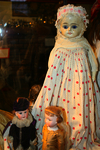
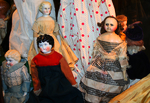 Dolls were precious to the children of Victorian times. The wealthy could give their children more elaborate dolls while the poorer class would have homemade or rag dolls. The earliest dolls have been made from materials such as stone, wood, clay, paper, plastic and porcelain. During the Victorian era dolls were mostly manufactured in porcelain. Porcelain became popular at the beginning of the 19th century and was used generically to refer to both china and bisque dolls. China heads made for dolls were mostly used in the 1840’s, and then in the 1860’s bisque heads were used to look more like skin.
Dolls were precious to the children of Victorian times. The wealthy could give their children more elaborate dolls while the poorer class would have homemade or rag dolls. The earliest dolls have been made from materials such as stone, wood, clay, paper, plastic and porcelain. During the Victorian era dolls were mostly manufactured in porcelain. Porcelain became popular at the beginning of the 19th century and was used generically to refer to both china and bisque dolls. China heads made for dolls were mostly used in the 1840’s, and then in the 1860’s bisque heads were used to look more like skin. 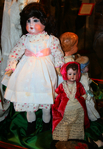 Before the Victorian period, dolls were always a representation of an adult figure; however the baby doll became popular in the 1850’s. One of the first dolls that portrayed a baby was made in England from wax. Doll hair was originally made of wool but the use of real human hair became popular in the mid 1800’s. A doll with human hair allowed the hair to be brushed, combed, braided and adjusted to the latest hair styles. Before the Victorian era the dominant eye color for dolls was brown; blue eyes became more popular from the inspiration of Queen Victoria. Fashion dolls of the time were dressed elaborately to represent the current style of the people. These dolls were used for show in the home and were not meant to be play things for little girls.
Before the Victorian period, dolls were always a representation of an adult figure; however the baby doll became popular in the 1850’s. One of the first dolls that portrayed a baby was made in England from wax. Doll hair was originally made of wool but the use of real human hair became popular in the mid 1800’s. A doll with human hair allowed the hair to be brushed, combed, braided and adjusted to the latest hair styles. Before the Victorian era the dominant eye color for dolls was brown; blue eyes became more popular from the inspiration of Queen Victoria. Fashion dolls of the time were dressed elaborately to represent the current style of the people. These dolls were used for show in the home and were not meant to be play things for little girls. 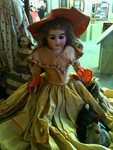 [Left] This antique French fashion was dressed to show the current style of the time. She dressed in an orange and yellow taffeta dress and dates back to around 1890.
[Left] This antique French fashion was dressed to show the current style of the time. She dressed in an orange and yellow taffeta dress and dates back to around 1890. Gift of Maude E. Barlow
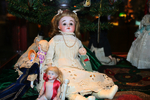
[Right] This doll, named Ruthie, was given as gift to Marguerite Gurley Chapman in 1891. The doll is dressed in a white leather dress with the markings “Made in Germany” on her neck. The doll is made of human hair which was popular of the time and adds to the value of it today.
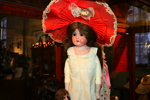 [Left] Armand Marseille dolls are one of the most common antique dolls that can be found today. The company was started by Armand Marseille, of Koppelsdorf Germany, in 1865; however the company didn’t start making doll heads until 1885. From 1900-1930, the company produced over 1,000 dolls heads per day. Most commonly found are the doll molds 370, which is a shoulder head on cloth or kids body and 390, a socket head on a composition body. The majority of the types of dolls were doll faced child dolls, babies and toddlers mostly made of bisque. Marseille didn’t produce the body of the doll but rather purchased them from other doll manufactures. The doll here is marked “Germany 370” on the back of her neck.
[Left] Armand Marseille dolls are one of the most common antique dolls that can be found today. The company was started by Armand Marseille, of Koppelsdorf Germany, in 1865; however the company didn’t start making doll heads until 1885. From 1900-1930, the company produced over 1,000 dolls heads per day. Most commonly found are the doll molds 370, which is a shoulder head on cloth or kids body and 390, a socket head on a composition body. The majority of the types of dolls were doll faced child dolls, babies and toddlers mostly made of bisque. Marseille didn’t produce the body of the doll but rather purchased them from other doll manufactures. The doll here is marked “Germany 370” on the back of her neck. Gift of the Krebs family.
Examples came from the estate of Olive Moffett, Marguerite Gurley Chapman, the Krebs family, Maude E. Barlow, Gertrude L. Murphy, PSTC Museum Knowles Estate, and Delbert Hicks..
MERCURY GLASS
(COLLECTION ON LOAN FROM CARL STICKNEY )

(COLLECTION ON LOAN FROM CARL STICKNEY )

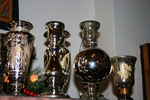 Mercury Glass is the commonly used term for silvered glass, which describes glass that was blown double walled, and then silvered between the layers with a liquid silvering solution, and sealed. Silvered glass was free-blown by a skilled craftsman. then silvered with an unusual solution containing a mixture of silver nitrate and grape sugar and finally heated and then closed. Although the element Mercury was used in mirrors, it was never used in the production of “Mercury” glass, despite the name!
Mercury Glass is the commonly used term for silvered glass, which describes glass that was blown double walled, and then silvered between the layers with a liquid silvering solution, and sealed. Silvered glass was free-blown by a skilled craftsman. then silvered with an unusual solution containing a mixture of silver nitrate and grape sugar and finally heated and then closed. Although the element Mercury was used in mirrors, it was never used in the production of “Mercury” glass, despite the name! 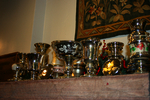 The methods of sealing included metal discs covered with a glass round (used mostly in England), or a cork inserted into the unpolished pontil scar which was the preferred method in the United States. The pontil was the rod through which the craftsman “blew” the glass into the desired shape. When the glass was cooled, the pontil was broken off, leaving an uneven pontil scar or circular mark. Silvered glass was one of the earliest forms of Art Glass, which was decorative glass that was made for display purposes and for its beauty rather than for utilitarian everyday use.
The methods of sealing included metal discs covered with a glass round (used mostly in England), or a cork inserted into the unpolished pontil scar which was the preferred method in the United States. The pontil was the rod through which the craftsman “blew” the glass into the desired shape. When the glass was cooled, the pontil was broken off, leaving an uneven pontil scar or circular mark. Silvered glass was one of the earliest forms of Art Glass, which was decorative glass that was made for display purposes and for its beauty rather than for utilitarian everyday use. 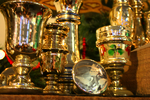 “Mercury” silvered glass was produced from circa 1840 up to 1930. Centers in Europe included Bohemia (now the Czech Republic) and England. Outstanding manufacturers in the United States included the Boston and Sandwich Glass Company, the New England Glass Company, and the Boston Silver Glass Company. The peak of production in America was from about 1852 to 1880. Many reproductions are made today, but generally can be distinguished from true antique silvered glass because they generally lack the double wall and they have a smooth solid bottom, unlike true pontilled silvered glass with its pontil scar.
“Mercury” silvered glass was produced from circa 1840 up to 1930. Centers in Europe included Bohemia (now the Czech Republic) and England. Outstanding manufacturers in the United States included the Boston and Sandwich Glass Company, the New England Glass Company, and the Boston Silver Glass Company. The peak of production in America was from about 1852 to 1880. Many reproductions are made today, but generally can be distinguished from true antique silvered glass because they generally lack the double wall and they have a smooth solid bottom, unlike true pontilled silvered glass with its pontil scar. VICTORIAN SILVER
(From the Museum collection and anonymous loans)

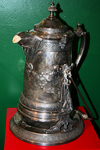 VICTORIAN SILVER is marked with exuberance, bringing silver to a new high point in popularity. The western expansion and discovery of silver in Nevada (Comstock Lode) and Idaho did much to force the price of silver down, (1850- 1875 répliques de montres Omega), thus increasing the number of people who could afford silver. The price which had hovered around $ 1.035 per ounce, suddenly dipped to $.61 per troy ounce because of the sheer volume of silver entering the market.
VICTORIAN SILVER is marked with exuberance, bringing silver to a new high point in popularity. The western expansion and discovery of silver in Nevada (Comstock Lode) and Idaho did much to force the price of silver down, (1850- 1875 répliques de montres Omega), thus increasing the number of people who could afford silver. The price which had hovered around $ 1.035 per ounce, suddenly dipped to $.61 per troy ounce because of the sheer volume of silver entering the market.
SILHOUETTES
The cutting of portraits became popular in the mid 18th century however the term “silhouette” started being used in the early 19th century. A silhouette is an image of a person or object in a single color, usually black, seen in profile. Prior to the invention of photography, silhouettes were the cheapest way of recording a person’s appearance. The advantage of a profile portrait is that its seen clear and simple since it relied on perfect proportions of the forehead, nose and chin. The markets for silhouette portraits were travelers and immigrants who wanted to bring family mementos with them. They served as valuable keepsakes for families separated by distances.
Silhouettes were highly popular in America from about 1790 to 1840. The invention of the camera started the decline of silhouette art. However in the 20th century a rise in traveling silhouette artists continued to work at state fairs. Today only about 15 silhouette artists remain in the United States.
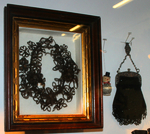 During the Victorian Period (1837-1901), the interior of the home became a showcase for a woman’s best handiwork and decorative taste. The term “fancy work” described both functional and aesthetic objects that a Victorian woman created or embellished in her free time. From about 1850 to 1890, one of the most popular forms of handcrafted fancywork was the Hair Wreath. Appealing to the desire among many Victorian women to incorporate the importance of family and friends into their work, hair wreaths served as a tangible and permanent remembrance of someone.
During the Victorian Period (1837-1901), the interior of the home became a showcase for a woman’s best handiwork and decorative taste. The term “fancy work” described both functional and aesthetic objects that a Victorian woman created or embellished in her free time. From about 1850 to 1890, one of the most popular forms of handcrafted fancywork was the Hair Wreath. Appealing to the desire among many Victorian women to incorporate the importance of family and friends into their work, hair wreaths served as a tangible and permanent remembrance of someone.
In many instances, close companions and husbands and wives interwove their hair into the wreaths. Hair was also taken after a person’s passing as a means of honor and remembrance and made into memorial and mourning wreaths. For a woman whose personal supply fell short, hair swatches could even be purchased from mail order catalogs and stores. Hair wreaths were more likely displayed in the parlor, the room in which guests were received.
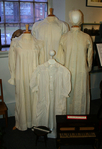 Nightgowns were worn by men, women and children and were usually made of cotton, linen and flannelette Ruffles, lace and embroidery were used to ornament neck, sleeves and body of the gown.
Nightgowns were worn by men, women and children and were usually made of cotton, linen and flannelette Ruffles, lace and embroidery were used to ornament neck, sleeves and body of the gown.
Nightgown c. 1880 - Man's heavy white cotton nightgown, ankle length with machine embroidered front panel. Button and buttonhole closure down center front. Small collar. [Gift of Mrs. Green 1969-20.14]
Nightgown c. 1876 - Woman's floor length, white linen nightgown. Front has vertical inserts of embroidered ribbon alternating with machine made lace and edged with a scalloped lace extending the full length of the gown. Lace collar and button closure down front. Long sleeves end with some embroidered ribbon and machine lace edged with the scalloped lace. [Gift of Mrs. E. E. Crandall 1948-5.12C]
Nightcap c.1845 - Woman's hand sewn nightcap of white muslin, with embroidered, white outline stitched leaves, vines and grapes. Parts of two ties indicate that the cap was tied under the chin. "Nina A. Bynton" marked in ink on lower center back. This cap was part of the trousseau of Mrs. Richard (Elvira) Harris, great aunt of the donor. [Gift of Mrs. H. B Church 45-5.1]
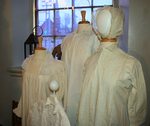 Nightgown c.1890-1910 - Woman's nightgown of cotton. Full length, long gathered sleeves. Large collar and insert have machine embroidered ribbon and eyelet ruffle. Long gathered sleeves end in eyelet ruffle. [Gift of Helen Reynolds fro the Grace Sisson Estate 1947-13.24]
Nightgown c.1890-1910 - Woman's nightgown of cotton. Full length, long gathered sleeves. Large collar and insert have machine embroidered ribbon and eyelet ruffle. Long gathered sleeves end in eyelet ruffle. [Gift of Helen Reynolds fro the Grace Sisson Estate 1947-13.24]
Nightgown c.1880 - Boy's nightgown of long, white cotton with long sleeves. Fabric gathered in front and back in yoke. Lace around cuffs and collar. Mother of pearl buttons down front of gown. [Gift of Remington Art Museum 1975-20]
Silhouettes were highly popular in America from about 1790 to 1840. The invention of the camera started the decline of silhouette art. However in the 20th century a rise in traveling silhouette artists continued to work at state fairs. Today only about 15 silhouette artists remain in the United States.
VICTORIAN HAIR WREATHS
 During the Victorian Period (1837-1901), the interior of the home became a showcase for a woman’s best handiwork and decorative taste. The term “fancy work” described both functional and aesthetic objects that a Victorian woman created or embellished in her free time. From about 1850 to 1890, one of the most popular forms of handcrafted fancywork was the Hair Wreath. Appealing to the desire among many Victorian women to incorporate the importance of family and friends into their work, hair wreaths served as a tangible and permanent remembrance of someone.
During the Victorian Period (1837-1901), the interior of the home became a showcase for a woman’s best handiwork and decorative taste. The term “fancy work” described both functional and aesthetic objects that a Victorian woman created or embellished in her free time. From about 1850 to 1890, one of the most popular forms of handcrafted fancywork was the Hair Wreath. Appealing to the desire among many Victorian women to incorporate the importance of family and friends into their work, hair wreaths served as a tangible and permanent remembrance of someone.In many instances, close companions and husbands and wives interwove their hair into the wreaths. Hair was also taken after a person’s passing as a means of honor and remembrance and made into memorial and mourning wreaths. For a woman whose personal supply fell short, hair swatches could even be purchased from mail order catalogs and stores. Hair wreaths were more likely displayed in the parlor, the room in which guests were received.
VICTORIAN FASHION
 Nightgowns were worn by men, women and children and were usually made of cotton, linen and flannelette Ruffles, lace and embroidery were used to ornament neck, sleeves and body of the gown.
Nightgowns were worn by men, women and children and were usually made of cotton, linen and flannelette Ruffles, lace and embroidery were used to ornament neck, sleeves and body of the gown.Nightgown c. 1880 - Man's heavy white cotton nightgown, ankle length with machine embroidered front panel. Button and buttonhole closure down center front. Small collar. [Gift of Mrs. Green 1969-20.14]
Nightgown c. 1876 - Woman's floor length, white linen nightgown. Front has vertical inserts of embroidered ribbon alternating with machine made lace and edged with a scalloped lace extending the full length of the gown. Lace collar and button closure down front. Long sleeves end with some embroidered ribbon and machine lace edged with the scalloped lace. [Gift of Mrs. E. E. Crandall 1948-5.12C]
Nightcap c.1845 - Woman's hand sewn nightcap of white muslin, with embroidered, white outline stitched leaves, vines and grapes. Parts of two ties indicate that the cap was tied under the chin. "Nina A. Bynton" marked in ink on lower center back. This cap was part of the trousseau of Mrs. Richard (Elvira) Harris, great aunt of the donor. [Gift of Mrs. H. B Church 45-5.1]
 Nightgown c.1890-1910 - Woman's nightgown of cotton. Full length, long gathered sleeves. Large collar and insert have machine embroidered ribbon and eyelet ruffle. Long gathered sleeves end in eyelet ruffle. [Gift of Helen Reynolds fro the Grace Sisson Estate 1947-13.24]
Nightgown c.1890-1910 - Woman's nightgown of cotton. Full length, long gathered sleeves. Large collar and insert have machine embroidered ribbon and eyelet ruffle. Long gathered sleeves end in eyelet ruffle. [Gift of Helen Reynolds fro the Grace Sisson Estate 1947-13.24]Nightgown c.1880 - Boy's nightgown of long, white cotton with long sleeves. Fabric gathered in front and back in yoke. Lace around cuffs and collar. Mother of pearl buttons down front of gown. [Gift of Remington Art Museum 1975-20]



